I have a specific issue (at least I like to think that :)). I want to align three plots in two columns and two rows. The alignment should be after the central plot (see pic; plot C) where plot A should align after x-axis of plot C and plot D should align after y-axis of plot C. Note, there is no plot B, this should stay empty.
Data:
a <- data.frame(
id = 1:15,
GO = c(
"phosphoglycerate kinase", "phosphoglycerate kinase",
"phosphoglycerate kinase", "phosphoglycerate kinase", "phosphoglycerate kinase",
"phenylalanine-tRNA ligase", "phenylalanine-tRNA ligase", "phenylalanine-tRNA ligase",
"phenylalanine-tRNA ligase", "phenylalanine-tRNA ligase", "allantoicase",
"allantoicase", "allantoicase", "allantoicase", "allantoicase"),
variable = c(
"d64", "d31", "d16", "d9", "d0", "d64", "d31", "d16", "d9", "d0", "d64", "d31", "d16", "d9", "d0"),
value = c(
154.28239, 226.04355, 245.67728, 271.82375, 270.83519, 289.01809, 491.66461,
485.28291, 351.3759, 510.96043, 22.75253, 31.66546, 129.50564, 206.6651, 32.43769),
relAbundByGO = c(
13.201624, 19.342078, 21.022096, 23.259395, 23.174806, 13.57975, 23.101262,
22.801413, 16.509683, 24.007892, 5.378513, 7.485456, 30.614078, 48.853948, 7.668005),
GOd = c(
"phosphoglycerate kinase", "phosphoglycerate kinase",
"phosphoglycerate kinase", "phosphoglycerate kinase", "phosphoglycerate kinase",
"phenylalanine-tRNA ligase", "phenylalanine-tRNA ligase", "phenylalanine-tRNA ligase",
"phenylalanine-tRNA ligase", "phenylalanine-tRNA ligase", "allantoicase",
"allantoicase", "allantoicase", "allantoicase", "allantoicase"
))
b <- data.frame(
id = 1:15,
Compound = c(
"C5-C10", "C5-C10", "C5-C10",
"C5-C10", "C5-C10", "C10-C20", "C10-C20", "C10-C20", "C10-C20",
"C10-C20", "BTEX", "BTEX", "BTEX", "BTEX", "BTEX"),
Degradation = c(
100, 100, 23.5, 5.6, 0, 100, 100, 67.2, 19, 0.6, 100, 100, 88.7, 43.3, 0.1),
st ()dev = c(
0, 0, 35, 12.4, 0, 0, 0, 19.3, 13.1, 0.6, 0, 0, 33.4, 43.4, 0.2),
day = c(
"NSWOD-0", "NSWOD-64", "NSOD-9",
"NSOD-16", "NSOD-31", "NSWOD-0", "NSWOD-64", "NSOD-9", "NSOD-16",
"NSOD-31", "NSWOD-0", "NSWOD-64", "NSOD-9", "NSOD-16", "NSOD-31"))
This is a try with cowplot:
a$GO <- factor(a$GO, levels = a$GO) #keep the same order as in table
a$variable <- factor(a$variable, levels = c("d0", "d64", "d9", "d16", "d31"))
p1 <- ggplot(data = a, aes(x=variable, y=GO)) +
geom_tile(aes(fill=relAbundByGO), colour = "white") + ylab("Gene ontology") +
scale_fill_gradient(name="Relative\nabundance of TPM", low = "green", high = "red", limits=c(0, 100), na.value="transparent") +
scale_x_discrete("Sample",
breaks = c("d0", "d64", "d9", "d16", "d31"),
labels = c("CTRL-0", "CTRL-64", "CEWAF-9","CEWAF-16","CEWAF-31")) +
theme(legend.position="left")
p1
a$GO <- factor(a$GO, levels = a$GO) #keep the same order as in table
p2 <- ggplot(data = a, aes(x=GO, y=value)) +
geom_bar(stat = "identity") +
theme(axis.text.x = element_text(angle = 0)) +
ylab("Cumulative TPM abundance") +
theme(axis.text.y=element_blank(),
axis.title.y=element_blank()) +
coord_flip()
p2
b$day <- factor(b$day, levels = b$day) #keep the same order as in table
p3 <- ggplot(b, aes(x=day, y=Degradation, color=Compound, group=Compound)) +
geom_point(size=4, shape=21, fill="white") +
geom_line(size=0.7) +
ylab("Hydrocarbon content (%)") +
geom_errorbar(aes(ymax=Degradation + stdev, ymin=Degradation-stdev), linetype="dashed", lwd=.6, width=.4) +
theme_bw(base_size = 12, base_family = "Helvetica") +
theme(axis.text.x=element_blank()
,axis.ticks=element_blank()
,axis.title.x=element_blank(),
legend.position="left") +
scale_color_discrete(name="Hydrocarbon\ngroup",
breaks=c("C5-C10", "C10-C20", "BTEX", "PAHs"))
p3
legend_p1 <- get_legend(p1)
legend_p3 <- get_legend(p3)
p1 <- p1 + theme(legend.position='none')
p3 <- p3 + theme(legend.position='none')
cowplot::plot_grid(
cowplot::plot_grid(legend_p3, legend_p1, ncol = 1),
cowplot::plot_grid(p3, NULL, p1, p2, ncol = 2, nrow = 2, rel_widths = c(1, 0.75, 1, 0.75), labels = c('A', '', 'C', 'D'), align = "hv"),
rel_widths = c(0.16, 1))
I would like to have plot D very close to plot C
Deni
